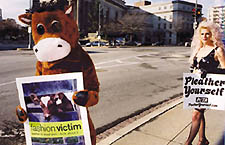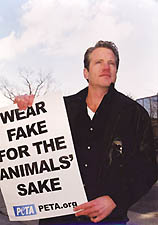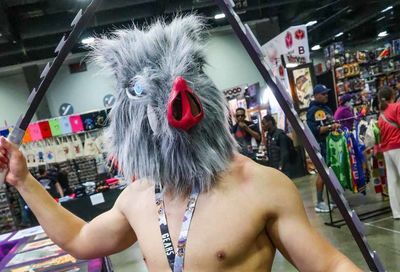Showing Some Skin
PETA Asks the Leather Community to Remove its Clothes
Photography by Michael Wichita
 |
Between the ASGRA gay rodeo and leather weekend, the gay community ensures that D.C. will experience an influx of both chaps and animal rights activists at least twice a year. Last Friday, January 17, peevish families staying at the Washington Plaza Hotel had not one, but two different unconventional groups to hide their children’s eyes from.
“We hope that when people see how easy it is to look sleazy without wearing leather, they’ll be sympathetic, ” says Dan Mathews, who is gay and Director of People for the Ethical Treatment of Animals (PETA). “It’s easy to have a look that kills without killing. ”
A handful of PETA activists braved subfreezing temperatures and arctic-like wind chills to encourage Mid-Atlantic Leather (MAL) Weekend participants to eschew their animal-based ensembles. To showcase what they view as a viable alternative to clothes made of cowhide, the activists were dressed in “Pleather ” jackets, skirts, pants and hats. One activist wore a cow suit and held a sign that read “Fashion Victim: Leather is Dead Skin — Think About It. ”
“It’s the 21st century, ” says Kayla Worden, campaign coordinator for PETA, who wore a fake-leather microskirt and halter-top for the occasion. “There are so many sexy, stylish, comfortable synthetics that are available. What we want to do is show people that there are other choices, that you can choose compassion over killing. ”
Standing on the sidewalk, the activists prompted some honks from passing cars and handed drivers a pamphlet entitled “PETA’s Shopping Guide to Nonleather Products. ” They were quick to point out that they have no beef (ahem) with Leather Weekend’s sexual side — all of the PETA protesters were gay themselves — only what they see as the animal cruelty aspect of it. But at the end of the day, many MAL participants were still unconvinced of the virtues of fake leather.
|
“I personally don’t feel that there’s anything wrong with wearing leather, ” says MAL participant Boris Mos, after flipping through the PETA literature. “I’m pro-animal rights, but you can use animals for lots of different things as long as you do it in a respectful way. ”
According to PETA, however, the treatment of cows used for leather is anything but respectful. PETA reports that cows are “castrated, branded, tail-docked [their tails amputated] and dehorned without anesthesia. Then they are trucked to slaughter, bled to death and skinned. ”
“I think most people are caring when they realize that every year, millions of cows go through slaughter kicking and screaming, ” says Worden.
Despite Worden’s optimism, however, the reactions of many MAL participants ranged from ambivalent to defensive.
“I don’t have a whole lot of sympathy, ” said Michael Syrjanen of Mephisto Leathers, one of many booths in the MAL marketplace selling various leather outfits and toys. “The fake leather is uncomfortable and hot. Real leather breathes. It’s natural and beautiful. ”
Mathews disagrees.
“It’s not sexy — it’s rotting skin with chemicals on it, ” he insists. “People grow up with such limited ideas of what’s sexy and what’s edgy. Sex is about cutting loose and having fun. There’s nothing fun about animals being skinned. ”
Leith Chu, Mr. Atlantic Canada Leather 2001, suggests that the imitation-leather industry may be even more harmful to animals than the slaughterhouses.
“My problem with fake leather is that it’s processed. It’s usually made from petrochemicals and the end result is that a lot more damage is done to the environment and the animals living in it by the chemicals. ”
Chu also holds that leather is a byproduct of cows that are already being killed for meat, and so its use is simply in the spirit of maximizing the use of the animal.
 |
“No one’s killing cows just for the leather, ” he says. “Since leather is a byproduct of meat, and since I’m not vegetarian, it would be very hypocritical of me to not wear leather because I think it’s cruel. In fact, using leather is ensuring that you’re using a hundred percent of the product [the cow]. ”
But according to Worden, the non-vegetarian argument doesn’t work.
“Red meat production has been steadily declining since the 1970s, ” she says. “Skins actually account for 55 to 60 percent of the byproduct value of cattle. So if you’re wearing leather, you’re directly supporting cruelty to animals. ”
Though the vast majority of the leather community still wears real leather, an animal-friendly niche is making its way in. A website called VeganErotica.com sells clothing, toys and restraints, all made of a synthetic leather material called Lorica that is 50% polyamide microfiber and 50% polyurethane. According to the website’s proprietor, Eric Ward, Lorica is imported from Italy and is fully breathable, permeable to water vapor, machine washable and stain resistant, and is used by many companies to make belts, bags and other leather synthetic goods.
Still, in the end, the leather community is just that: a leather community, and a major turnaround in attitudes toward natural cowhide doesn’t seem imminent. Patti Brown, manager of the Leather Rack in Dupont Circle, sums up his opinions on animal rights in one sentence.
“People have rights, animals have uses. ”
Support Metro Weekly’s Journalism
These are challenging times for news organizations. And yet it’s crucial we stay active and provide vital resources and information to both our local readers and the world. So won’t you please take a moment and consider supporting Metro Weekly with a membership? For as little as $5 a month, you can help ensure Metro Weekly magazine and MetroWeekly.com remain free, viable resources as we provide the best, most diverse, culturally-resonant LGBTQ coverage in both the D.C. region and around the world. Memberships come with exclusive perks and discounts, your own personal digital delivery of each week’s magazine (and an archive), access to our Member's Lounge when it launches this fall, and exclusive members-only items like Metro Weekly Membership Mugs and Tote Bags! Check out all our membership levels here and please join us today!





















